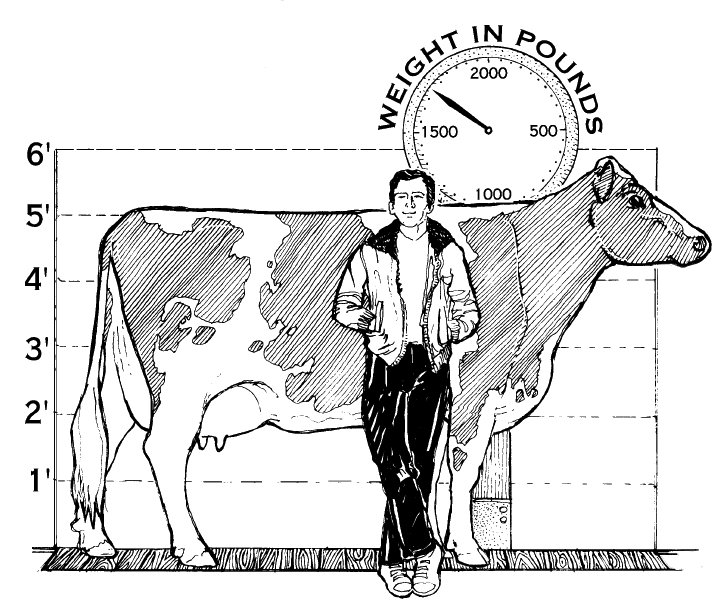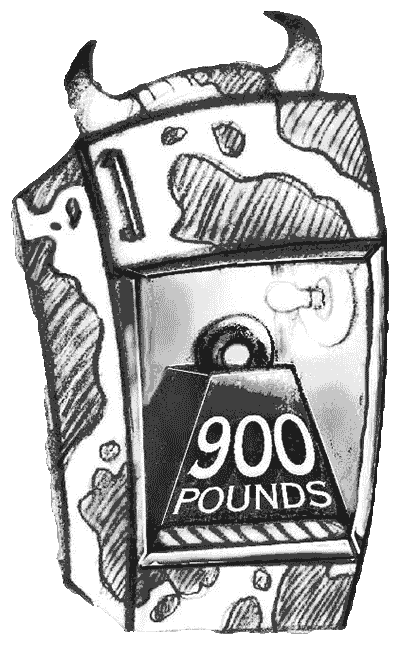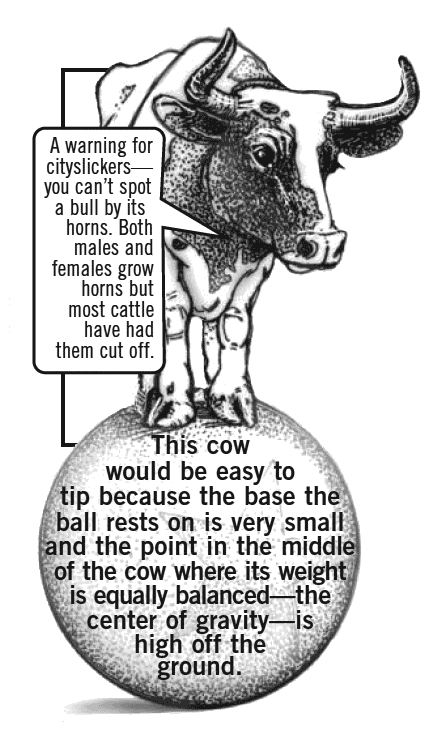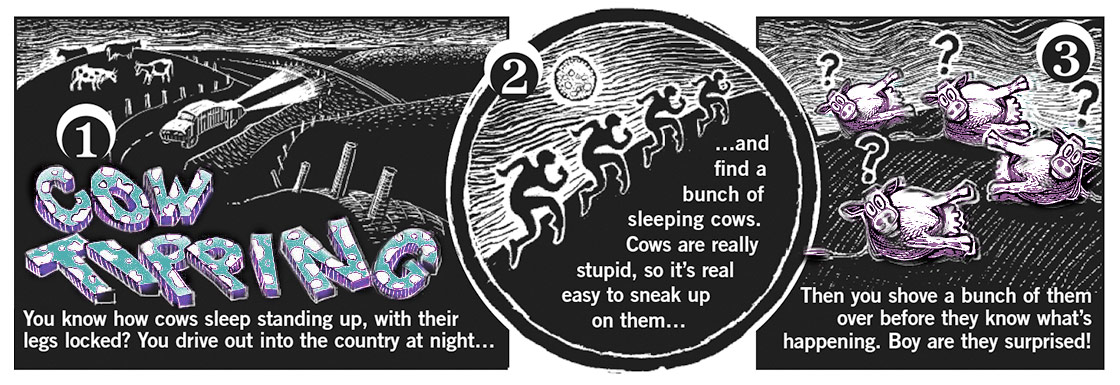The following article, written for children, is from Junior Skeptic # 5 on Urban Legends, published in Skeptic magazine issue 7.2 (1999). Click image below to enlarge it.
We call this the most urban (city-like) of all Urban Legends because it’s a story believed by city folk, although farm people have been known to tell it as a tall tale. Anyone who has ever worked closely with cows knows that almost every statement in the cow tipping story is false (as we will explain below). But you will probably find that you don’t have to ask very many people to find someone who absolutely swears they tipped cows over exactly the way it’s described in the cartoon above.
Why People Who Know About Cows Think That the Cow Tipping Story is Largely an Urban Legend
Cartoon panel 1 (top of this article): There is no such thing as a cow “locking its legs.” They don’t have to because cows sleep lying down (people may be confusing them with horses which do sleep standing up).
Cartoon panel 2: Cows don’t sleep for hours at a time like people do. The sleeping habits of cattle developed when they were prey animals hunted by predators. Most of their “sleeping” is very light—more what we would consider a very relaxed state. This kind of sleep is easily interrupted and allows them to be aware of their surroundings. Cows also need about an hour of a deeper kind of sleep which they take in short naps of a few minutes each spread over a 24 hour period. Because each individual cow spends so little time in deep sleep most cows in a herd are alert even at night. It’s not that easy to sneak up on a herd of cows. Domesticated cows are relatively calm animals but they are spooked by unexpected events. Cows still have the characteristics that kept them alive when they were wild animals avoiding predators. They have eyes on the side of their heads so they can see in all directions and ears as big as feet for purposes of detecting possible attackers. One alerted animal easily transfers its concern to the others in the herd. If you live in a town you may not realize how incredibly quiet it can be out in the country at night. You can hear a lone car coming for several minutes, the noise of the engine slowly increasing as it approaches. A carload of excited teens who stop along side a pasture at night, suddenly switch off the engine, scramble out, slam the car doors, and try to figure out how to squeeze through a tightly strung barbed wire fence in the dark would be hard for a cow to miss.
Cartoon panel 3: Cows are much bigger than most people realize. In the unlikely event that a cow would stand still as you approached, is it even possible to simply shove one over? Did you ever try, as a kid, to run at an older teen or adult in order to slam into them and knock them down? If you have, you know that it’s really difficult to knock someone off their feet if they weigh even 50 pounds more than you do. The black and white spotted Holstein—by far the most common dairy cow—could easily weigh more than 10 times what a potential cow tipper weighs. The cows can weigh 1500 to 1800 pounds, and the bulls can weigh over a ton! Cows are also used to responding to pushes and shoves from the rest of the animals in the herd. The top of a Holstein’s back can be five feet or more high. Plus a cow has the advantage of standing on four feet instead of two feet. Junior Skeptic scientist Tom McDonough estimates the force necessary to tip a cow (below).
Dr. Tom Mcdonough’s Science of Bovodynamics

The modern Holstein dairy cow is an enormous animal. Many people who claim that they’ve pushed a cow like this over have probably never been near one because they typically describe the cow’s back as being only 3½ to 4 feet high.

(Bovodynamics, or BVD for short, is our name for the silly Science of Cow Tipping. The name combines “bovine,” an old word for cow from Latin, with “dynamics” the study of energy or objects in motion.) In the cow tipping story the cow must be tipped with a single shove before it can react to the tipper. Dr. McDonough has developed a simple computer program to estimate the amount of force it takes to shove over an object based on its weight, center of gravity and the height of its legs. If you’d like to know what tipping a cow would be like, try tipping over a refrigerator with a single shove. McDonough calculates that it would take a shove of 35 pounds of force to tip a typical home refrigerator. But a cow like the one above weighs about 8 times as much as a refrigerator! You’d first need to pack the refrigerator with 900 pounds of lead weights to duplicate the cow tipping effect. (The higher you place the weight the less you’ll need. Top-heavy items tip easier because gravity helps pull them over as the weight shifts to one side.)
Can a Person Really Tip a Cow, and Why Don’t We Just Go Out and Try It?

The direct approach is usually the best way to find something out. But we would never recommend trying to tip a live animal because from what we already know it’s likely that either the cow or the would-be tipper might be injured.
- Bulls are often pastured with cows and they are genuinely dangerous.
- A cow tipper could get lucky and catch a cow off balance, or cause it to trip or slip. Large animals are easily injured by their own weight just falling from a standing height.
- You wouldn’t want to be trapped in the dark on foot if your actions caused the herd to begin running. Stampeding cattle are unpredictable.
The Psychology of Cow Tipping
The cow tipping story’s attraction is probably due to the fact that it allows a bunch of friends to pile into a car, drive around at night, have an adventure, and brag about it afterward. It may be that sending someone out to try to tip over a cow is like another joke also played on an unsuspecting greenhorn at night— “snipe hunting.” A person new to a group is invited to go snipe hunting. They are taken out into the country at night, told to wait in a particular spot for the snipes, and abandoned. The joke is to see how long a person will wait before realizing they’ve been had. The next time an unsuspecting new victim joins the group it would not be surprising to find that the previous victim is the person who suggests a snipe hunt and describes the adventure with the most enthusiasm. ![]()
We thank dairyman Carl Knudtson and his family for providing the cow measurements for the calculations in this article.
















